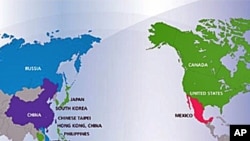Trade ministers with the Asia Pacific Economic Cooperation (APEC) forum meet this week in the western U.S. state of Montana. The meeting is one of a series leading up to an APEC summit in Hawaii in November.
In Hong Kong and other Asian mega cities business is the life blood that drives the daily hustle and bustle in one of the most successful capitalist markets in the world.
It is a dynamism that relies heavily on exports.
Businessman Sunny Chai heads a manufacturing alliance in Hong Kong. He says removing barriers to trade must be among APEC's top priorities. "For member companies within the alliance, particularly those people who are selling raw materials or additives to materials for manufacturers within China, Thailand, Malaysia or Indonesia, I believe those kinds of manufacturers and companies will greatly benefit," he said.
|
APEC by the Numbers
|
With a market of more than two and a half billion consumers, APEC's 21 member countries account for about 55 percent of the world's GDP (gross domestic product) and 43 percent of global trade.
Economist Fred Bergsten says APEC's rise reflects the growing importance of the region. "Things have changed a lot, particularly the relative importance of China and the other Asian members of APEC. But it's interesting APEC has in fact renewed the goals that were initially created back in the 1993-1994 start up of the APEC summits. At that time the leaders agreed to create free trade and investment in the region by 2010 to 2020," he said.
Despite some progress in reducing tariffs, the goal of an Asia-Pacific wide free trade zone remains largely unfulfilled.
Bergsten says the Trans-Pacific Partnership proposed by the U.S. would level the playing field and create new opportunities on both sides of the Pacific. "The ASEAN countries [Association of Southeast Asian Nations] already have FTAs [free trade agreements] with each of the big northeast Asian countries: China, Korea,Japan. There are other intra-Asian agreements and all of those inherently discriminate against U.S. trade, thus U.S. business and particularly U.S. workers," he said.
Those hurdles include preferential treatment among some trading partners and uneven economic growth among member countries. Another is the currency dispute between the United States and China.
Despite Beijing's promise to make its currency more flexible, the yuan, or renmimbi, has gained only five percent since June.
The U.S. insists China's undervalued currency gives its exports an unfair advantage.
But Sunny Chai says Asian manufacturers are wary of the currency debate because any sudden moves could affect their bottom line. "So when the [China's] currency goes up, the entire direct cost goes up so this is not a good thing for the manufacturers," he said.
Despite ongoing differences, Bergsten says there is room for agreement.
At the trade ministers meeting in Montana beginning Thursday, discussions will range from export regulations to the development of incentives to promote trade in green technologies.
But Bergsten says broader initiatives are likely to take place later this year. "I think President Obama has a huge opportunity to assert leadership in the region, try to move APEC toward the goal of free trade in the region and I think there's a good chance there will be important progress toward that to report at the summit in Hawaii in November," he said.
APEC represents a significant forum for American companies wishing to expand. Together the APEC countries purchase 58 percent of all U.S. exports. Trade officials say continued growth in the region is crucial to the administration's plan to double U.S. exports and create two million jobs.










